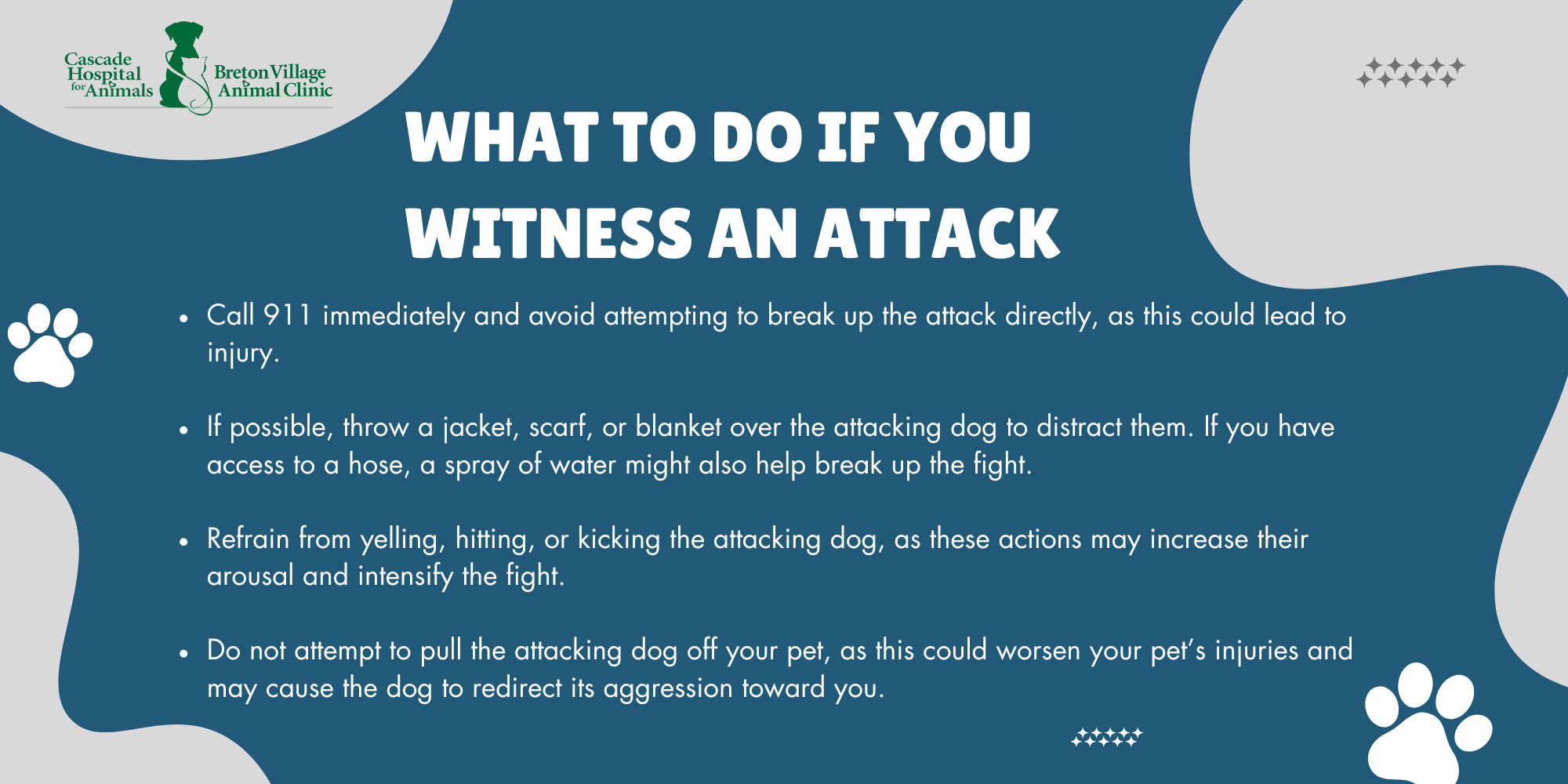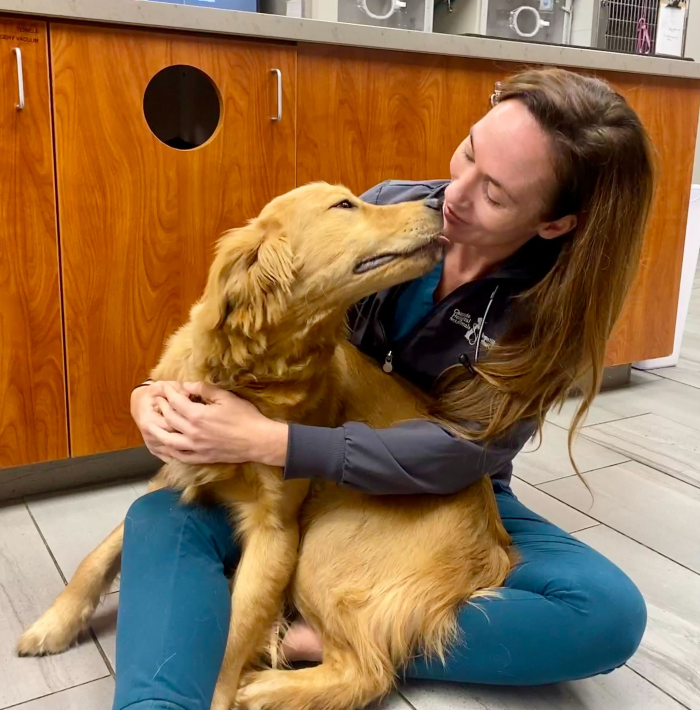
What to Do if Your Dog is Bitten: Expert Tips from Dr. Dana Isard
Photo: Dr. Isard and Jones at his recent appointment unrelated to a dog bite.
A dog bite is a frightening experience for any pet parent, and knowing the right steps to take can make a huge difference in your dog’s recovery. Dr. Dana Isard of Cascade Animal Hospital shares key actions you should take if your dog is bitten, along with how to determine when professional care is needed, and tips for monitoring the healing process.
Immediate First Steps
According to Dr. Isard, the first priority after a dog bite incident is getting your pet to a safe space. “If the pet who bit is a housemate, separate the animals to reduce the likelihood of subsequent attacks when arousal levels are high,” she advises. This can help prevent any further injuries and allow you to assess the situation calmly. After separating the pets, inspect your dog for visible injuries, as bite wounds can vary in severity.
If another pet guardian is involved, exchange contact details in case follow-up is necessary. Dr. Isard also recommends contacting local authorities if the bite occurs on public property, which can help document the incident properly and initiate any needed legal procedures.
Is It an Emergency?
Bite wounds are often more serious than they appear, even when they seem small. Dr. Isard stresses, “If your pet has any puncture wounds, even if they are small, your pet should be seen by a veterinarian as soon as possible.” Bite wounds can cause internal damage and may be more extensive beneath the skin. If no wounds are visible and your dog is moving around normally, a regular appointment may suffice. However, erring on the side of caution with an immediate vet visit is often the best course of action.
Watching for Signs of Infection
Even after receiving treatment, it’s crucial to monitor your pet’s bite wound for signs of infection. Dr. Isard explains, “Bites are always infected, and if a wound is present, antibiotics are warranted.” Indicators of infection include increased redness, warmth around the wound, discharge, or any unusual odor. If you notice these symptoms, return to the vet promptly for a recheck.
Cleaning the Wound
Although it’s tempting to clean the wound at home, Dr. Isard advises against this unless you are instructed to do so by a veterinarian. “Sterile saline is the most appropriate for wound cleaning,” she explains. However, cleaning should be done in a sterile environment, ideally at a veterinary clinic, where proper care can be taken to avoid introducing further infection. Never use household substances like peroxide, vinegar, or bleach, as they can damage the cells necessary for healing.

Reporting the Bite
If your dog is bitten by another domestic animal, it's important to document the incident thoroughly and consider reporting it to local authorities. According to Dr. Isard, keeping a clear and detailed record of the situation can be crucial. Write down key information as soon after the incident as possible, including the location of the bite, the behavior of both animals leading up to it, and contact information for any witnesses who observed the event. This documentation can help provide clarity for authorities if further investigation is needed.
Information to Collect
If the animal that bit your dog has an identifiable guardian, try to gather their contact information, along with any available rabies tag or license numbers for the biting animal. This information can be helpful to veterinarians in assessing any potential health risks to your dog and may also be valuable for authorities should they need to investigate the incident further. Accurate and prompt information can streamline the process of evaluating health concerns and handling any necessary follow-up actions.
Veterinary Care and Healing
If your dog has suffered a bite wound, antibiotics are typically prescribed to prevent infection. In some cases, especially if your dog’s rabies vaccination status is not up-to-date, a rabies booster may be necessary. During recovery, Dr. Isard recommends monitoring the wound closely, ideally by taking daily photos to track progress and share with your veterinarian if there are any concerns.
Dr. Isard notes that “activity restriction” is often necessary for dogs recovering from a bite. Overexertion could lead to the wound reopening, delayed healing, or the need for additional surgical intervention.
Recognizing an Impending Attack
Understanding body language can sometimes prevent a bite from happening in the first place. Signs that a dog may be preparing to bite include tense body posture, a low growl, or a sudden change in movement, such as a freeze or slow-motion approach. In these cases, giving both dogs a moment to de-escalate may help avoid an aggressive encounter.
For more information on defensive handling, consider watching this helpful video for tips on reducing the likelihood of a bite when approached by an off-leash dog.
 Dog bites can be stressful, but by acting quickly and following Dr. Isard's guidelines, you can help ensure your pet’s recovery process is smooth and safe. By focusing on immediate care, gathering essential information, and consulting your vet for follow-up care, you’ll be taking the best steps to support your dog’s healing.
Dog bites can be stressful, but by acting quickly and following Dr. Isard's guidelines, you can help ensure your pet’s recovery process is smooth and safe. By focusing on immediate care, gathering essential information, and consulting your vet for follow-up care, you’ll be taking the best steps to support your dog’s healing.
Located in the heart of West Michigan, serving Ada, Cascade, Forest Hills, and the greater Grand Rapids area, Cascade Hospital for Animals and Breton Village Animal Clinic are trusted havens for vet care. Reach out today to schedule a comprehensive physical examination for your pet.



